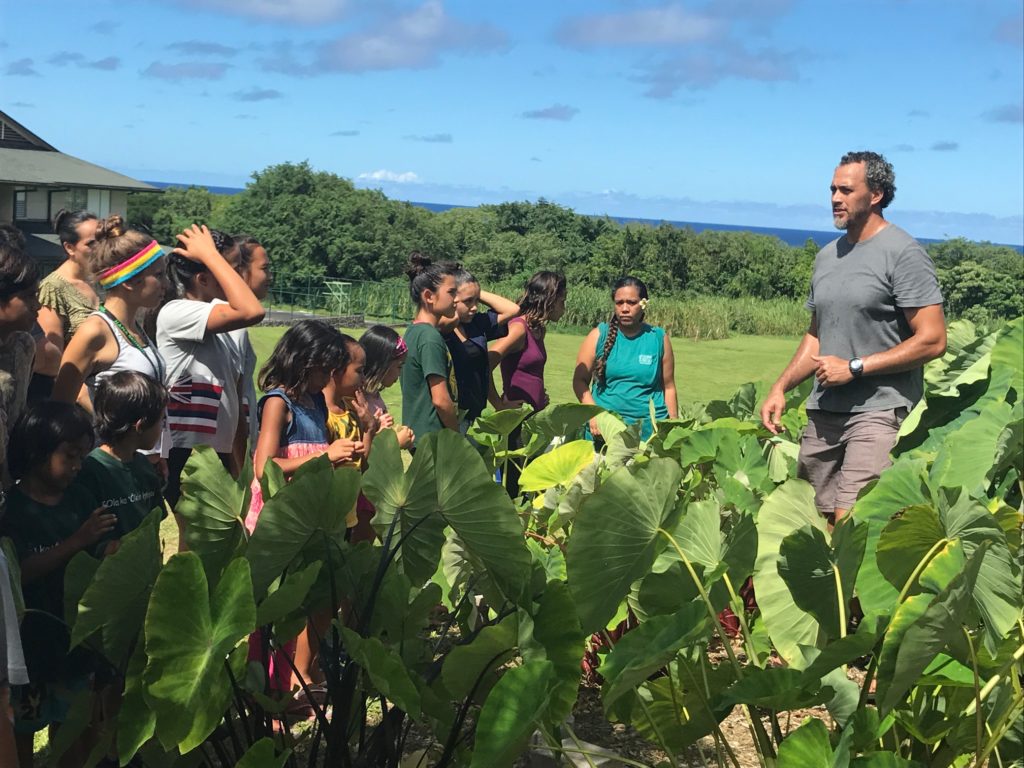Kamehameha Schools Invests $1.7 M in Maui Programs

Ma Ka Hāna Ka ‘Ike is among several programs on Maui, Moloka‘i and Lāna‘i which are collaborating with Kamehameha Schools to construct the right environment for Native Hawaiian learners to flourish.
Kamehameha Schools has awarded more than $1.7 million in community investment grants to support collaboration partners on Maui, Moloka‘i and Lāna‘i for the current fiscal year which began July 1.
Ma Ka Hāna Ka ‘Ike’s Sustainable Building Program is among several programs on Maui, Moloka‘i and Lāna‘i which are collaborating with Kamehameha Schools to construct the right environment for Native Hawaiian learners to flourish.
Self-sustenance, community relationship and cultural connection are some of the principles Ma Ka Hāna Ka ‘Ike aims to pass onto the next generation by creating caretakers of the future and leaders of Maui.
For Ma Ka Hāna Ka ‘Ike’s Sustainable Building Program, Mahele Farm Program and Ku‘i ‘Ai Program, that means the ability to work with hundreds of community members from keiki to kūpuna in providing essential vocational skills, ‘āina-based education, pono stewardship, culture-based and opportunities and community empowerment.
Overall, Kamehameha Schools has awarded $24 million in grants statewide for this fiscal year.
The grants target four primary priorities statewide – $4.6 million for early learning, $12 million for kindergarten-to-grade-12 education, $4.25 million for college and career focus and $3 million for ‘āina and community engagement – with the goal of improving native Hawaiian learner outcomes in kindergarten readiness, 3rd grade reading scores, 8th grade math scores, on-time high school graduation rates and completion of post-secondary education.
“These grants support areas such as Hawaiian cultural-based immersion and charter schools, early education programs, ‘āina-based learning opportunities, vocational training and undergraduate and graduate internships,” said Lauren Nahme, Vice President of Strategy and Innovation. “As part of our Strategic Plan for 2020 and Vision 2040, we join with these community collaborators in working toward building a thriving lāhui.”
Statewide, several organizations received grants for multiple projects:
- ‘Aha Pūnana Leo – Funding support that includes per-pupil funding for Ke Kula ‘O Nāwahīokalani’ōpu‘u Iki Laboratory Public Charter School in East Hawai‘i and Ke Kula Ni‘ihau O Kekaha.
- University of Hawai‘i – To support a number of programs including teacher education, college readiness and internships.
- Ho‘okāko‘o Corporation – For support of Kamaile Academy, Ke Kula Kualapu‘u and Waimea Middle School.
- Kanu o ka ‘Āina Learning ‘Ohana – To support the West Hawai‘i school’s K-12 and early childhood education initiatives.
- Friends of the Leeward Coast – Includes support for Ka Waihona o ka Na‘auao Public Charter School’s per-pupil funding and integration of STEM and ‘ike Hawai‘i practices.
For time first time, Kamehameha Schools is providing multi-year funding to core collaboration efforts with charter schools, organizations stewarding KS ‘āina, and other critical partners.
In addition to the $24 million, Kamehameha Schools is honoring another $3 million in continued commitments to projects such as:
- Polynesian Voyaging Society’s final year of the Mālama Honua Worldwide Voyage.
- The University of Hawai‘i’s Makalapua Na‘auao – a four-year scholarship program for Native Hawaiian students attending U.H.
- Chaminade University’s Ho‘oulu STEM (Science, Technology, Engineering and Math) to boost the number of Native Hawaiian students pursuing and earning degrees in STEM fields.
“With this financial investment, we envision a brighter future for Native Hawaiians – a future that includes improved academic readiness, post-secondary success, increased career opportunities, a deeper connection to place, a focus on family engagement and a greater knowledge of Hawaiian values, practices and principles,” Nahme said.
Investments in programs and projects on Maui, Moloka ‘i and Lāna‘i totaled more than $1.7 million with some of the larger awards going to organizations such as:
- Hawaii Farmers Union Foundation for the Ku‘ia Agricultural Education Program for a program in Lāhainā to develop an agricultural education center based on sustainable and traditional Hawaiian agricultural practices.
- Ma Ka Hana Ka ‘Ike for the Sustainable Building Program, Māhele Farm Program, and Kui Ai Program to support vocational skills training, ‘āina- and culture-based education and kīpuka stewardship.
- Kauahea Inc. for the Paeloko Learning Center to provide cultural enrichment programs to Maui County Schools, cultural organizations and groups, after-school and weekend programs, and the general community.
- Hui o Kuapā for Mālama ia Keawanui for a project that combines experiential learning for K-20 students with the actual caretaking of the Keawanui loko i‘a as an ecological and economic system.
- Alaka‘ina for the Molokai Digital Bus -Project Nā Meaola. The project will bridge STEM and Native Hawaiian techniques and methodologies through meaningful science-based classroom and field experiences.
“Through these community investments, educational opportunities for Native Hawaiian learners on Maui, Moloka‘i and Lāna‘i will be built upon a foundation of traditional values and strengthened through Hawaiian cultural-based education and ‘āina-based learning,” said Maui, Moloka‘i & Lāna‘i Regional Director Venus Rosete-Medeiros. “We see a bright future across the pae‘āina.”
For a list of other community resources on Maui, Moloka‘i and Lāna‘i, visit www.ksbe.edu/maui_molokai_lanai/.










